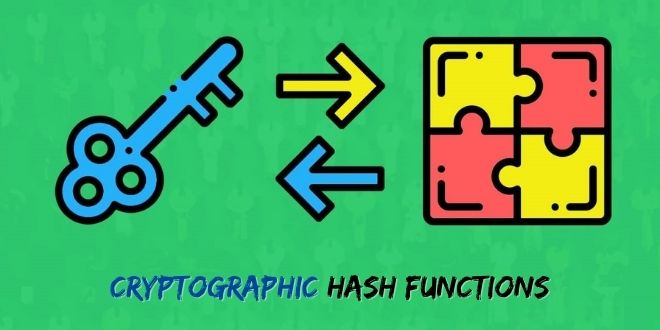What is the four letter word that implies a tasty breakfast and also a plant that has pointy leaves? If you guessed “hash” then you are absolutely correct. But other than that, this word also has implications in the cryptographic domain and that is what we are going to discuss in this article. This article will act as a guide on what cryptographic hash functions are.
What Are Cryptographic Hash Functions?
A cryptographic hash function is a mathematical operation that is used in cryptography. Usual hash functions take reports of variable lengths to return outputs of a determined length. A cryptographic hash function mixes the message-passing abilities of hash functions with security features.
Hash functions are generally used as data modules in computing systems for activities, like checking the integrity of messages and verifying information. While they are thought of as cryptographically “weak” as they can be solved in a polynomial time span, they are not decipherable easily.
Cryptographic hash functions add security options to typical hash functions, making it harder to detect the contents of a message or data regarding senders and recipients. In general, cryptographic hash functions portrays these three properties:
- They are “collision-free.” This implies that no 2 input hashes should map to a similar output hash.
- They can be hidden. It should be hard to guess the input value for a hash operation from its output.
- Also, they should be puzzle-friendly. It should be hard to choose an input that offers a predefined output. Hence, the input should be chosen from a distribution that is as wide as possible.
The three features illustrated above are desirable but they cannot always be enacted in practice. For instance, the variation in sample spaces for input hashes and outputs assures that collisions are possible. For instance, in 2017, the MIT Digital Currency Initiative found collision vulnerability in IOTA.
How Are Cryptographic Hash Functions Different From Other Hash Functions?
All hash functions in cryptography are hash functions. But not all hash functions are cryptographic hash. A CHF aims to assure a number of security qualities. Most crucially that it is difficult to find pre-images or collisions and that the output looks random.
Instances Of Cryptographic Hash Functions
Cryptographic hash functions are widely employed in digital currencies to pass transaction data anonymously. For instance, Bitcoin, the original and biggest digital currency, uses the SHA-256 cryptographic hash operation in its algorithm. Similarly, IOTA, an exchange for the IoT (Internet of Things), has its own cryptographic hash operation, known as Curl. However, hashes have other operations in the real world. These are some of the most usual cryptographic hash function examples. These can also be used as applications of cryptographic hash functions.
Password Verification
Keeping passwords in a normal text file can be harmful, so nearly all websites store their passwords as hashes. When a user inserts their passwords, it is hashed and its results are compared to the list of all the hashed values that are stored on the server of the company. This process is not a fool-proof practice, however, as the Collection #1 trove of 21 million stolen passwords, discovered in 2019, illustrates.
Signature Generation And Verification
Authenticating signatures is a mathematical process employed to verify the authenticity of digital messages or documents. A valid virtual signature, where the prerequisites are met, offers its receiver strong proof that the message was formulated by a known sender and that the message was not changed in transit. A digital signature mechanism typically comprises three algorithms which are a signing algorithm that provides a message and also a private key, which offers a signature; a key generation algorithm; and a signature that verifies the algorithm. Merkle Trees, a technology used in digital currencies, is a kind of virtual signature.
Verifying File and Message Integrity
Hashes can be utilized to assure files and messages transmitted from sender to receiver are not being tampered with during transit. The practice creates a “chain of trust.” For instance, a user might issue a hashed version of their information and the key so that recipients can collate the hash value they compute to the issued value to assure they align.
Advantages And Disadvantages Of Cryptographic Hash Functions
Cryptographic hash functions are algorithms that take an arbitrary portion of data input which is a credential, and produce a fixed-size output of encrypted text known as a hash value, or just “hash.” With that, let us have a look at the advantages and disadvantages of cryptographic hash functions.
Pros
Cryptographic hashes accept cleartext passwords and change them into encrypted text for storage. Attackers who enter your database are forced to decode those hash values if they aim to exploit them. In other words, hashes slow down the number of attackers on your website.
Cons
Simple hash functions can slow down attackers, but finally, attackers will be able to overcome them.
- Attackers fitted with quick hardware can conveniently “crack” hashed credentials.
- Good hash algorithms are formulated to be collision-resistant, but collisions are not possible to discard completely. SHA-1 and MD5 are among the types of hash functions that have been proven to have known collisions, that is, creating the same hash value from varied credentials.
- Rainbow tables are “optimized lookup tables” that can be utilized to reverse-engineer one-way hash functions. A rainbow table is primarily a pre-computed set of plaintext strings and also their corresponding hashes. Big rainbow tables are publicly accessible, and attackers can avail of one of these tables to regain cleartext data that has been hashed.
Conclusion
Cryptographic hash functions do offer hindrances to attackers, such as speed bumps slowing down a speeding motorcycle. But it is important to remember that eventually, the motorcycle will still make it down the lane. However, these constraints will slow down your defenders along with normal users and your server. Set the speed bump too high, and you operate the risk of annoying your user and overtaxing your server.
But no matter how high you create your speed bump, an attacker will finally be able to overcome it. The prevailing challenge is to slow down attackers while balancing the satisfaction and requirements of your users.
- The Bitcoin Wallet Boom: Why Demand Is Skyrocketing - 25/11/2023
- How To Choose The Best Crypto Exchange Affiliate Programs - 03/03/2023
- Crypto License: How To Get It Now? - 03/02/2023
 Crypto Venture News One stop Crypto Track Down
Crypto Venture News One stop Crypto Track Down 






